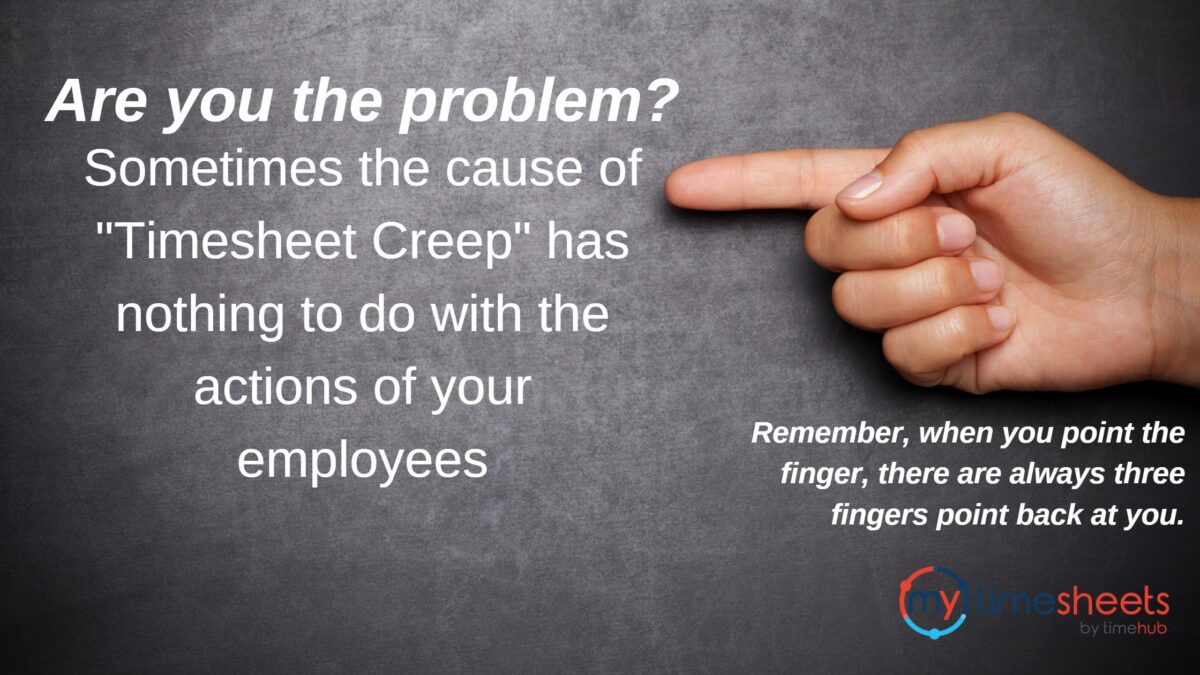Timesheet Creep is a multifaceted problem that can be experienced by any business.
It is not always intentional, it can be hard to detect, and it requires diligence and oversight to eliminate it.
TimeCreep is among the largest hidden costs to any business.
It can be caused by employees naively thinking "it's ok" to crib a bit of time here and there or a manager turning a blind eye because it is easier than confronting the situation.
It can also be caused by simple miscalculations or miskeyed data.
Interestingly we have seen situations where management have either contributed to or compounded the problem.
These include:
- Lack of a clear policy on attendance
Not having a written and signed Time and Attendance policy, with specific instructions on honesty and fraud. (If you would like a free copy of our Time and Attendance policy template email [email protected])
- Untrained managers
Not training managers and supervisors on why actively managing employee attendance is important and how to spot issues.
- Inaction by managers
Not raising Time Keeping issues with employees as soon as they happen.
- Favouritism
Favouritism can happen where managers or supervisors apply different rules for different employees.
- Using manual systems
Using manual systems such as paper timesheets that do not capture hours worked in "real-time" and that is open to interpretation if not abuse.
- Out of sight out of mind
Not having suitable processes and procedures for employees who work remotely or who work in the field to ensure the reliability of time records.
- The belief that implementing a new system will cost money so managers stick to inaccurate manual processes in the false belief that they don't cost money.
While there will be costs associated with implementing a new system, the cost of not making a change can be far greater
- The curse of - “We’ve always done it this way”
This is not a business strategy. If you don’t compare your current method to the alternatives, you will never find out if there is a better way.
- The false belief that “This does not apply to us”
One of the most telling findings we see is that most employers who experienced these issues were not aware they had a problem.
We recommend you take the time to analyse your time and attendance processes to see if you have an issue?
The first step is to carry out a detailed “needs analysis”.
Through this, you can gain an understanding of the technical/functional requirements of your time and attendance structure as well as consider the aspects of your current processing method that you like and dislike. You can also consider what you would like in a new system that you do not currently have.
When performing this initial review, we suggest you consider the following analysis technique:
-
- Current situation - What is the current situation you face with your existing system? What are your specific “non-negotiable” requirements?
- Problems - What prompted you to look at a new Time and attendance system. What are the problems or deficiencies of the current system? Be ruthless here. People often say, “We know the existing system has problems, but we know what they are, and we know how to work around them”!
- Implications - Having identified the problem areas, try to assess what the implications of these problems are on you, your staff or your business (e.g., if you ascertain that not having detailed historical reporting is a problem, why is it a problem and what is the negative implication of this?)
- Benefits of change - For each of the problems you have identified and found a negative implication for, consider what the positive implication would be of having a solution to your problem. For example, using our “reports” scenario above, the “benefit of change” would be that you do not have to do vast amounts of manual analysis of paper-based reports.
Whether the issue is blatant time theft or more insidious Time Creep the impact in terms of actual cost or more importantly the effect on staff morale, can be huge.
The good news is there is a solution and it is not as difficult as you may think. But it will take a proactive approach on the part of everyone in the business.
If you would like to go through a no-obligation analysis of your current process, with a view to finding a better way, simply click on this link to book a time with Steve - Book a No-Obligation Review
